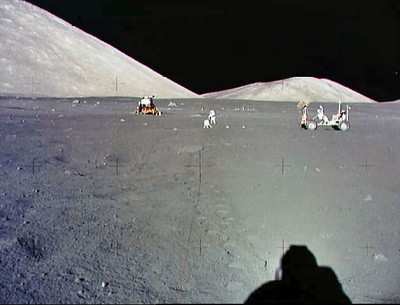Concentrations Of Moon Water Up To 100 Times More Than
Previously Thought
 A team of NASA-funded researchers has measured for the first
time water from the moon in the form of tiny globules of molten
rock, which have turned to glass-like material trapped within
crystals. Data from these newly-discovered lunar melt inclusions
indicate the water content of lunar magma is 100 times higher than
previous studies suggested.
A team of NASA-funded researchers has measured for the first
time water from the moon in the form of tiny globules of molten
rock, which have turned to glass-like material trapped within
crystals. Data from these newly-discovered lunar melt inclusions
indicate the water content of lunar magma is 100 times higher than
previous studies suggested.
The inclusions were found in lunar sample 74220, the famous
high-titanium "orange glass soil" of volcanic origin collected
during the Apollo 17 mission in 1972. The scientific team used a
state-of-the-art ion microprobe instrument to measure the water
content of the inclusions, which were formed during explosive
eruptions on the moon approximately 3.7 billion years ago.
The results published in the May 26 issue of Science Express
raise questions about aspects of the "giant impact theory" of how
the moon was created. That theory predicted very low water content
of lunar rock due to catastrophic degassing during the collision of
Earth with a Mars-sized body very early in its history. The study
also provides additional scientific justification for returning
similar samples from other planetary bodies in the solar system.
"Water plays a critical role in determining the tectonic behavior
of planetary surfaces, the melting point of planetary interiors and
the location and eruptive style of planetary volcanoes," said Erik
Hauri, a geochemist with the Carnegie Institution of Washington and
lead author of the study. "I can conceive of no sample type that
would be more important to return to Earth than these volcanic
glass samples ejected by explosive volcanism, which have been
mapped not only on the moon but throughout the inner solar
system."

Apollo 17 Lunar Rover
In contrast to most volcanic deposits, the lunar melt inclusions
are encased in crystals that prevent the escape of water and other
volatiles during eruption. "These samples provide the best window
we have on the amount of water in the interior of the moon where
the orange glass came from," said science team member James Van
Orman of Case Western Reserve University in Cleveland.
In a 2008 study led by Alberto Saal of Brown University in
Providence, RI, the same team reported the first evidence of water
in lunar volcanic glasses. They used magma degassing models to
estimate how much water was originally in the magmas before
eruption. Building on that study, a Brown undergraduate student,
Thomas Weinreich, searched for and found the melt inclusions. With
that data, the team measured the pre-eruption concentration in the
magma and estimated the amount of water in the moon's interior.
"The bottom line is that in 2008, we said the primitive water
content in the lunar magmas should be similar to lavas coming from
the Earth's depleted upper mantle," Saal said. "Now, we have proven
that is indeed the case."
The study also puts a new twist on the origin of water-ice
detected in craters at the lunar poles by several recent NASA
missions. The ice has been attributed to comet and meteor impacts,
but the researchers believe it is possible that some of the ice
came from water released by the eruption of lunar magmas eons
ago.

Apollo 17 Lunar Surface
The paper entitled, "High Pre-Eruptive Water Contents Preserved
in Lunar Melt Inclusions," was written by Hauri, Weinreich, Saal,
Van Oman and Malcolm Rutherford of Brown. The research is funded by
NASA's Lunar Advanced Science and Exploration Research and
Cosmochemistry Programs in Washington, the NASA Lunar Science
Institute (NLSI) at the agency's Ames Research Center at Moffett
Field, CA, and the Astrobiology Institute at Ames.
The NLSI is a virtual organization enabling collaborative,
interdisciplinary research in support of agency lunar science
programs. The researchers are members of NLSI teams from the
Southwest Research Institute in San Antonio and Brown. The
institute uses technology to bring scientists together around the
world, and it is comprised of seven competitively selected U.S.
teams and several international partners. NASA's Science Mission
and Exploration Systems Mission Directorates in Washington fund the
institute.
 ANN's Daily Aero-Linx (04.15.24)
ANN's Daily Aero-Linx (04.15.24) Classic Aero-TV: 'No Other Options' -- The Israeli Air Force's Danny Shapira
Classic Aero-TV: 'No Other Options' -- The Israeli Air Force's Danny Shapira Aero-News: Quote of the Day (04.15.24)
Aero-News: Quote of the Day (04.15.24) Airborne 04.16.24: RV Update, Affordable Flying Expo, Diamond Lil
Airborne 04.16.24: RV Update, Affordable Flying Expo, Diamond Lil ANN's Daily Aero-Term (04.16.24): Chart Supplement US
ANN's Daily Aero-Term (04.16.24): Chart Supplement US





